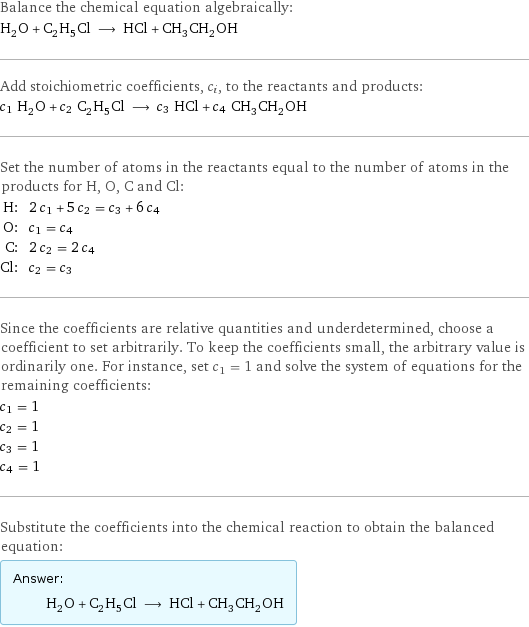Input interpretation

H_2O water + C_2H_5Cl chloroethane ⟶ HCl hydrogen chloride + CH_3CH_2OH ethanol
Balanced equation

Balance the chemical equation algebraically: H_2O + C_2H_5Cl ⟶ HCl + CH_3CH_2OH Add stoichiometric coefficients, c_i, to the reactants and products: c_1 H_2O + c_2 C_2H_5Cl ⟶ c_3 HCl + c_4 CH_3CH_2OH Set the number of atoms in the reactants equal to the number of atoms in the products for H, O, C and Cl: H: | 2 c_1 + 5 c_2 = c_3 + 6 c_4 O: | c_1 = c_4 C: | 2 c_2 = 2 c_4 Cl: | c_2 = c_3 Since the coefficients are relative quantities and underdetermined, choose a coefficient to set arbitrarily. To keep the coefficients small, the arbitrary value is ordinarily one. For instance, set c_1 = 1 and solve the system of equations for the remaining coefficients: c_1 = 1 c_2 = 1 c_3 = 1 c_4 = 1 Substitute the coefficients into the chemical reaction to obtain the balanced equation: Answer: | | H_2O + C_2H_5Cl ⟶ HCl + CH_3CH_2OH
Structures

+ ⟶ +
Names

water + chloroethane ⟶ hydrogen chloride + ethanol
Equilibrium constant
![K_c = ([HCl] [CH3CH2OH])/([H2O] [C2H5Cl])](../image_source/e7fc5f1b2430122e1566b86b17c0d46f.png)
K_c = ([HCl] [CH3CH2OH])/([H2O] [C2H5Cl])
Rate of reaction
![rate = -(Δ[H2O])/(Δt) = -(Δ[C2H5Cl])/(Δt) = (Δ[HCl])/(Δt) = (Δ[CH3CH2OH])/(Δt) (assuming constant volume and no accumulation of intermediates or side products)](../image_source/54e7ff2fc7651ca31761a0430e10b619.png)
rate = -(Δ[H2O])/(Δt) = -(Δ[C2H5Cl])/(Δt) = (Δ[HCl])/(Δt) = (Δ[CH3CH2OH])/(Δt) (assuming constant volume and no accumulation of intermediates or side products)
Chemical names and formulas

| water | chloroethane | hydrogen chloride | ethanol formula | H_2O | C_2H_5Cl | HCl | CH_3CH_2OH Hill formula | H_2O | C_2H_5Cl | ClH | C_2H_6O name | water | chloroethane | hydrogen chloride | ethanol